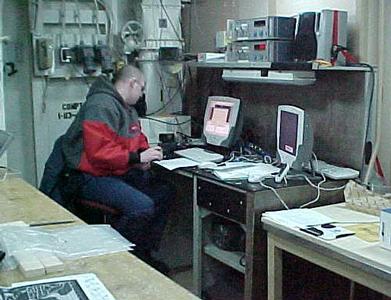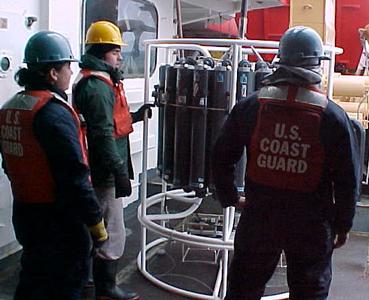
|
|
17 March, 2001
In 1741, Bering made his famous voyage of discovery. He sailed from
Petropavlovsk, Kamchatka, on the vessel St. Peter with a crew of 75,
including the naturalist Georg Stellar. Several animals were named after
Stellar. These include the Stellar sea lions, and the Stellar eider, a sea
duck of the genus Somaterior or related genera of northern regions. The
Stellar eider has soft, commercially valuable down and mostly back and
white plumage in the males. Also sailing was the vessel St. Paul, with a
crew of 76. The two ships were separated in a storm the first month out,
never to meet again. Bering made landfall, sighting Mt. St. Elias (on the
eastern side of the Gulf of Alaska). A few days later he put Stellar
ashore on Kayak Island for a few hours before heading home. Bad ending for
Bering though, the ship was driven ashore on Bering Island west of Attu and
there he perished of scurvy, a disease resulting in deficiency of vitamin C
and marked by spongy and bleeding gums, bleeding under the shin, and
extreme weakness.
We have had good luck with the weather so far. The air temperature this
morning was 29 degrees. The ship has been really smooth. We will begin
the benthic studies tonight. This involves using a van Venn to grab a
section of the sediment off the bottom of the ocean. This mud is placed on
screens. Once this is done, they are sprayed with a hose to remove the
sediment revealing the animals. These are collected and preserved so that
they can be counted and identified later.
Dr. Michael Simpkins and Lisa Hituki from the National Marine Mammal
Laboratory flew yesterday on the helicopter to survey for mammals. Little
was seen yesterday. The community of Gambell on St. Lawrence Island has
spotted beluga, bowhead and blue whales, seals, walrus, arctic fox, wolf,
and polar bears. The name "Beluga whale" is derived from the Russian word
for white. Only the adult belugas are white. We feel confident that
animals will be spotted once we hit ice. Cetaceans are completely aquatic
mammals: they feed, mate, calve, and suckle their young in the water. They
are the most specialized mammalian swimmers. They can travel up to 25 mph,
diving to depths of 10,000 feet, and remaining submerged up to 2 hours.
The tail is developed into horizontal flukes for propulsion. The smooth,
supple, hairless skin reduces drag during swimming. They breathe through
nostrils on top of their head called blowholes. The baleen whales are
filterfeeders that forage for zooplankton and small fish by swimming or
gulping huge amounts of prey and water. The water is then forced back out
the mouth past hundreds of baleen plates that act as sieves to trap prey,
which is then swallowed. The toothed whales have various numbers of
identical coned or spade shaped teeth that are used to grasp or strain
prey, primarily fish and quid. The bowhead and blue whales are mysticetes
(baleen whales). The beluga whales are odontocetes (toothed whales).
Three water sampling stations were completed during my shift today. I am
rotating jobs with the others on my shift. Today I collected water for
chlorophyll testing, and for nutrient analysis. We wear latex gloves to
provide a more pure sample. Small containers of water are collected from
the Niskins (see journal March 15) on the CTD. The nutrient sample goes
to the freezer and the O-18 samples are collected and remain at room
temperature. There were lots of jobs involved in preparing for the
benethic stations. While I was outside helping with setup, I discovered
ice in the ocean. We were coming closer and closer to it. I spent the
next 2 hours outside watching the ice and looking for animals. I climbed
to one of the highest decks. I was able to see seals and walrus. Walrus
are shy and they were fairly far off. They quickly dove underwater as we
came closer. It was very exciting.
The marine scientists as well as Dr. Lovvorn, Co-PI from the University of
Wyoming went out again today in the helicopter. They saw all sorts of
animals. The captain and pilot asked me if I wanted to go up in the
helicopter. I will be doing this when I visit the schools but it would be
fun to go out and look for animals.
Dinner tonight included all kinds of pizza. We had St. Patrick Day ice
cream sundaes. Green ice cream with toppings. Talk about yummy!

<> Ship's Marine Science Technicians preparing to deploy CTD device.

> <> CTD Operator monitors sensor readings from CTD device and closes bottles and specific depths.

<> Aerial view of CTD deployment.

<> View of CTD as it is raised from the water.

<> Pre-launch preparations for the CTD.
Contact the TEA in the field at
.
If you cannot connect through your browser, copy the
TEA's e-mail address in the "To:" line of
your favorite e-mail package.
|
